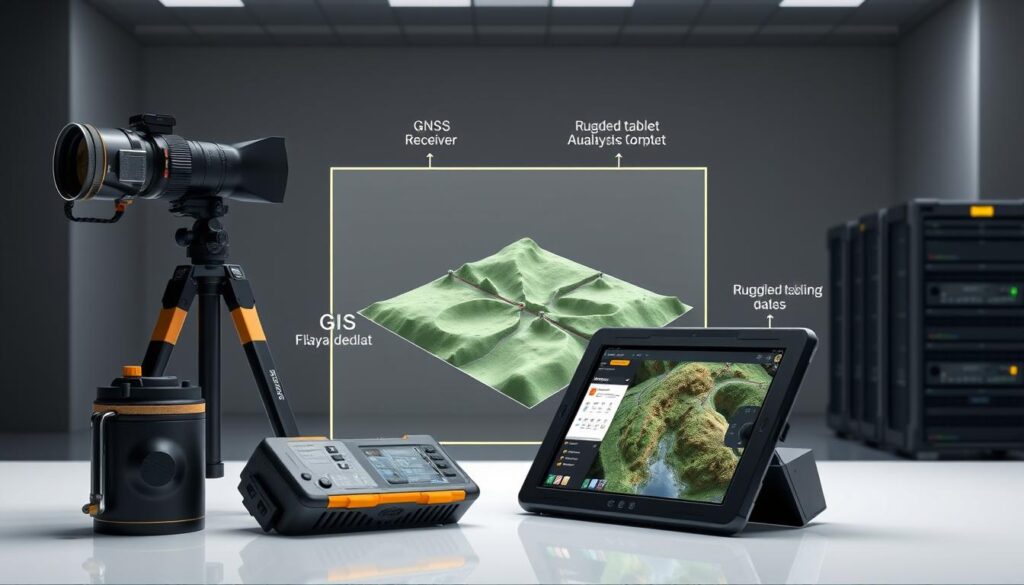The infrastructure landscape is undergoing a significant transformation, driven by the integration of geographic information systems into civil engineering practices. A staggering 70% of infrastructure projects worldwide face delays or cost overruns due to inadequate planning and data management.
This is where GIS technology steps in, revolutionizing the field by providing detailed insights, improving decision-making, and uncovering opportunities for more efficient and sustainable infrastructure development.
Key Takeaways
- GIS technology is transforming infrastructure projects worldwide.
- Improved data management leads to more efficient project execution.
- Better decision-making is enabled through detailed insights.
- Sustainability in infrastructure development is enhanced.
- GIS helps in uncovering hidden opportunities in infrastructure projects.
What is GIS and Why it Matters in Civil Engineering
GIS technology has become a cornerstone in civil engineering, offering a comprehensive framework for managing and analyzing spatial data related to infrastructure projects. This capability is crucial for civil engineers who need to make informed decisions based on precise geographic data.
Definition of GIS
A Geographic Information System (GIS) is a computer system that analyzes and displays geographically referenced information. It allows users to overlay different layers of data—such as topography, demographics, and infrastructure—onto maps and models tied to precise geographic locations. This enables civil engineers to visualize complex data in a spatial context, facilitating better planning and decision-making.
Importance in Infrastructure Projects
The importance of GIS in infrastructure projects cannot be overstated. GIS applications in civil engineering are diverse, ranging from site selection and environmental impact assessments to transportation planning and utilities management. By leveraging GIS, civil engineers can enhance project planning, improve decision-making, and increase the overall efficiency of infrastructure development.
Moreover, GIS facilitates the integration of various data sources into a single, cohesive platform. This integration is vital for analyzing complex infrastructure projects, where multiple factors such as environmental impact, cost, and feasibility need to be considered. By using GIS, civil engineers can create detailed models that simulate real-world conditions, allowing for more accurate predictions and better project outcomes.
Key Components of GIS Technology

Understanding the core components of GIS technology is crucial for its successful implementation in civil engineering. GIS technology excels in project visualization, particularly through its advanced 3D modeling and virtual reality (VR) capabilities. These tools enable project teams to visualize the final outcome of an infrastructure project before construction begins.
Data Input and Management
The foundation of any GIS project is its data. Efficient data input and management are critical for the accuracy and reliability of GIS outputs. This involves collecting data from various sources, including satellite imagery, GPS, and field surveys, and integrating it into a cohesive database.
Data management in GIS also involves ensuring data quality, handling large datasets, and providing secure access to data for various stakeholders. As noted by a GIS expert,
“The integrity of GIS outputs is directly dependent on the quality of the input data.”
Spatial Analysis Tools
Spatial analysis is a key feature of GIS technology, enabling users to analyze spatial data and derive meaningful insights. Spatial analysis tools allow for the examination of spatial relationships, patterns, and trends, which are crucial for decision-making in infrastructure projects.
These tools can be used for various analyses, including proximity analysis, network analysis, and terrain analysis. By leveraging these capabilities, civil engineers can make more informed decisions regarding project planning and execution.
Mapping Capabilities
GIS technology is renowned for its mapping capabilities, which enable the visualization of complex data in an intuitive and accessible format. Mapping is a powerful tool for communicating project plans and progress to stakeholders, facilitating better understanding and collaboration.
Advanced mapping capabilities, such as 3D modeling and VR, further enhance the visualization of infrastructure projects. As highlighted by a recent study,
“The use of 3D modeling and VR in GIS significantly improves project stakeholders’ understanding of complex infrastructure projects.”
Benefits of Implementing GIS in Civil Engineering
By leveraging GIS, civil engineers can now make more informed decisions throughout the project lifecycle. The comprehensive insights provided by GIS software for civil engineering enable better analysis and understanding of complex infrastructure projects.
Improved Decision-Making
The use of GIS in civil engineering significantly enhances decision-making processes. By analyzing spatial data and relating it to project requirements, engineers can identify potential issues early on. This proactive approach helps in mitigating risks and improving project outcomes.
“GIS technology allows for the integration of various data sources, providing a holistic view of infrastructure projects. This integrated approach facilitates more accurate planning and decision-making.” – Expert in GIS Applications
Enhanced Project Planning
GIS technology is instrumental in enhancing project planning. It allows for the creation of detailed maps and 3D models, which are crucial for understanding the project’s spatial context. This capability is particularly valuable in complex infrastructure projects where multiple stakeholders are involved.
| Project Aspect | Traditional Method | GIS-Enhanced Method |
|---|---|---|
| Data Analysis | Limited spatial analysis | Comprehensive spatial analysis |
| Project Visualization | 2D representations | 3D modeling and visualization |
| Stakeholder Engagement | Limited interactive tools | Interactive maps and dashboards |
Cost Efficiency
Implementing GIS in civil engineering also leads to significant cost efficiencies. By optimizing resource allocation and reducing the need for physical surveys, GIS technology helps in lowering project costs. For more information on how GIS is transforming civil engineering, visit https://www.encardio.com/blog/gis-in-civil-engineering.
In conclusion, the benefits of GIS in civil engineering are multifaceted, ranging from improved decision-making to enhanced project planning and cost efficiency. As the technology continues to evolve, its impact on the civil engineering sector is expected to grow, leading to more sustainable and efficient infrastructure projects.
GIS Applications in Urban Planning

The integration of GIS in urban planning has transformed the way cities are developed and managed. By utilizing spatial analysis tools, urban planners can make more informed decisions regarding infrastructure development and resource allocation.
Zoning and Land Use Analysis
GIS plays a crucial role in zoning and land use analysis by enabling the examination of spatial data to determine the most suitable land uses. This involves analyzing factors such as environmental constraints, population density, and existing land use patterns. For instance, GIS was instrumental in Melbourne’s EastLink tollway project, helping it finish ahead of schedule and saving thousands through efficiency gains.
Transportation Planning
In transportation planning, GIS is used to analyze and visualize transportation networks, traffic patterns, and infrastructure needs. This helps in designing more efficient transportation systems and in planning for future expansions. According to a study on civil engineering in project management, the use of GIS can significantly enhance project outcomes by improving planning and execution.
Utilities Management
GIS is also vital in utilities management, where it is used to map and manage utility infrastructure such as water, electricity, and gas networks. This enables utility companies to maintain their infrastructure more effectively and plan for upgrades and expansions. The spatial analysis capabilities of GIS allow for the identification of potential issues before they become major problems, thus reducing maintenance costs and improving service reliability.
By leveraging GIS technology, urban planners and utility managers can work together more effectively to create sustainable and efficient urban environments. The use of GIS in urban planning not only enhances decision-making but also contributes to the overall development of smart cities.
Integrating GIS with Other Technologies
Civil engineering is witnessing a significant shift with the integration of GIS and other cutting-edge technologies. This integration is not only enhancing the capabilities of GIS but also opening new avenues for infrastructure development and project management.
The integration of GIS with Building Information Modeling (BIM) is revolutionizing project management and operational workflows in civil engineering. By combining GIS and BIM, professionals can achieve a more comprehensive understanding of both the physical and functional characteristics of infrastructure projects.
Combining GIS with BIM
The fusion of GIS and BIM enables the creation of detailed 3D models that incorporate both spatial and non-spatial data. This integration facilitates better decision-making, improved collaboration among stakeholders, and more efficient project execution.
For instance, GIS provides the geospatial context, while BIM offers detailed information about building components. Together, they enable civil engineers to analyze the impact of infrastructure projects on the surrounding environment and make informed decisions.
Role of Remote Sensing
Remote sensing technology plays a crucial role in enhancing GIS capabilities. By capturing data from aerial and satellite imagery, remote sensing provides valuable insights into environmental changes, land use patterns, and infrastructure conditions.
This information is vital for civil engineers, as it helps in monitoring project progress, assessing environmental impacts, and identifying potential risks. The integration of remote sensing with GIS enables the creation of accurate and up-to-date maps, which are essential for effective project planning and management.
Use of Drones for Data Collection
Drones are increasingly being used in civil engineering for data collection and site monitoring. Equipped with high-resolution cameras and sensors, drones can capture detailed imagery and topographic data, which can be integrated into GIS systems.
The use of drones not only improves the accuracy of data collection but also reduces the time and cost associated with traditional surveying methods. Moreover, drones can access hard-to-reach areas, providing a more comprehensive view of the project site.
In conclusion, the integration of GIS with other technologies like BIM, remote sensing, and drones is transforming the civil engineering landscape. By leveraging these technologies, civil engineers can enhance project outcomes, improve decision-making, and drive innovation in infrastructure development.
GIS for Environmental Impact Assessments

The integration of GIS in environmental impact assessments is transforming the way we approach infrastructure development. By combining spatial data with environmental factors, GIS technology enables a more comprehensive analysis of potential impacts.
Evaluating Environmental Risks
GIS solutions for civil engineering projects allow for the evaluation of environmental risks by analyzing various data layers, including topography, land use, and natural resources. This spatial analysis helps in identifying areas that are more susceptible to environmental hazards.
Risk assessment becomes more precise with GIS, as it can integrate real-time data and historical trends to predict potential environmental impacts.
Mitigation Planning
Once environmental risks are identified, GIS aids in mitigation planning by providing a visual platform to strategize and implement measures to minimize these risks. It helps in designing infrastructure that is more resilient to environmental challenges.
GIS mapping capabilities enable stakeholders to visualize the impact of different mitigation strategies, facilitating more informed decision-making.
Ensuring Regulatory Compliance
GIS in civil engineering also plays a crucial role in ensuring regulatory compliance. By analyzing environmental data against regulatory standards, GIS helps in assessing whether a project meets the required environmental regulations.
This not only streamlines the compliance process but also reduces the risk of non-compliance, which can lead to costly delays or penalties.
Real-Time Data Collection and Monitoring
The integration of real-time data collection and monitoring has revolutionized the field of civil engineering through Geographic Information Systems (GIS). This advancement enables more accurate and timely decision-making, improving overall project management.
One of the key factors driving this revolution is the Internet of Things (IoT). IoT devices can be deployed across various infrastructure projects to collect real-time data on parameters such as structural integrity, environmental conditions, and traffic flow.
The Role of IoT in GIS
IoT technology plays a crucial role in enhancing GIS capabilities by providing real-time data. This data can be used to monitor the condition of infrastructure, predict potential failures, and optimize maintenance schedules.
- Real-time Monitoring: IoT sensors can monitor infrastructure conditions in real-time, enabling swift responses to changes or potential issues.
- Predictive Maintenance: By analyzing data from IoT devices, predictive models can be developed to forecast when maintenance should be performed, reducing downtime and improving asset longevity.
- Enhanced Decision-Making: The integration of IoT data with GIS allows for more informed decision-making by providing a comprehensive view of the infrastructure’s status.
Enhancements in Data Accuracy
The incorporation of real-time data collection and IoT technology significantly enhances the accuracy of GIS data. This improvement is crucial for civil engineering projects, where precise data informs design, construction, and maintenance decisions.
| Feature | Traditional GIS | GIS with Real-Time Data |
|---|---|---|
| Data Collection Method | Periodic Surveys | Continuous IoT Monitoring |
| Data Accuracy | Dependent on survey frequency | High accuracy, real-time updates |
| Decision-Making | Based on historical data | Informed by current conditions |
By leveraging real-time data collection and monitoring, civil engineers can significantly improve the management of infrastructure projects. This not only enhances the accuracy of GIS data but also supports more efficient and effective project execution.
Case Studies: Successful GIS Implementations

The implementation of GIS technology in civil engineering has led to numerous successful projects worldwide. This section highlights some of the most notable infrastructure projects that have benefited from GIS implementations.
Notable Infrastructure Projects
One of the standout examples is the M6 project in Sydney, which harnessed GIS technology to transform construction processes and decision-making. The use of GIS allowed for more efficient data management and spatial analysis, leading to improved project outcomes.
According to a report, “The integration of GIS with other technologies like BIM has opened new avenues for innovation in infrastructure projects.” Successful BIM-GIS integration projects have shown significant improvements in project delivery and management.
| Project Name | Location | GIS Application |
|---|---|---|
| M6 Project | Sydney | Construction process optimization |
| Transportation Upgrade | New York | Route planning and analysis |
| Urban Development | Los Angeles | Zoning and land use analysis |
Lessons Learned from Implementation
The successful implementation of GIS in these projects has provided valuable lessons. One key takeaway is the importance of data accuracy and management. Ensuring that the data fed into GIS systems is accurate and up-to-date is crucial for reliable outcomes.
“The accuracy of GIS data is paramount. Inaccurate data can lead to misguided decisions, potentially costing millions in project delays or failures.”
Another lesson learned is the need for comprehensive training for personnel using GIS technology. Effective use of GIS requires a deep understanding of both the technology and its applications in civil engineering.
In conclusion, the successful implementation of GIS in civil engineering projects has shown significant benefits. By learning from these case studies, future projects can be better planned and executed, leveraging the full potential of GIS technology.
Challenges in Adopting GIS Technology
Despite its numerous benefits, GIS technology adoption in civil engineering is not without its hurdles. The integration of GIS into civil engineering projects requires significant investment in terms of cost, resources, and training.
Cost and Resource Allocation
One of the primary challenges in adopting GIS technology is the cost associated with its implementation. This includes the cost of GIS software, hardware, and the training required for personnel to effectively use these tools. Efficient resource allocation is crucial to overcome these financial hurdles.
A detailed breakdown of the costs involved in GIS implementation can be seen in the following table:
| Cost Component | Description | Estimated Cost |
|---|---|---|
| GIS Software | Licensing fees for GIS software | $5,000 – $20,000 |
| Hardware | Servers, workstations, and other necessary hardware | $10,000 – $50,000 |
| Training | Training programs for personnel | $2,000 – $10,000 |
Training and Skill Development
The successful implementation of GIS technology also depends on the skills of the personnel using it. There is a need for comprehensive training programs to ensure that users can effectively utilize GIS tools for project planning and execution.
“The effective use of GIS requires not just the technology itself, but also a workforce that is skilled in its application.”
For more insights on the challenges faced in GIS adoption, visit https://www.fusegis.com/5-challenges.
Data Privacy Concerns
GIS technology involves the collection and analysis of large amounts of spatial data, raising concerns about data privacy and security. Ensuring that sensitive information is protected is a significant challenge that organizations must address.
In conclusion, while GIS technology offers numerous benefits to civil engineering, its adoption is accompanied by several challenges. Addressing these challenges effectively is crucial for the successful integration of GIS into civil engineering projects.
Future Trends in GIS for Civil Engineering

GIS technology is on the cusp of a significant transformation, driven by advancements in AI, machine learning, and cloud computing. As these technologies continue to evolve, they are expected to further enhance the capabilities of GIS in infrastructure management, offering civil engineers new tools and methodologies to improve project outcomes.
AI and Machine Learning Integration
The integration of artificial intelligence with GIS, known as GeoAI, is a groundbreaking advancement that is further enhancing the capabilities of GIS in infrastructure management. GeoAI enables more sophisticated spatial analysis in civil engineering, allowing for the prediction of complex phenomena and the optimization of infrastructure designs.
For instance, GeoAI can be used to analyze large datasets related to infrastructure projects, identifying patterns and trends that may not be apparent through traditional analysis methods. This can lead to more informed decision-making and improved project planning.
Advancements in Cloud Computing
Cloud computing is another trend that is significantly impacting the future of GIS in civil engineering. By leveraging cloud-based GIS solutions, civil engineers can access powerful computing resources and large datasets without the need for expensive hardware or infrastructure.
This shift towards cloud computing is facilitating greater collaboration and data sharing among stakeholders, enabling more efficient project delivery and improved outcomes. The scalability and flexibility offered by cloud-based GIS solutions are particularly beneficial for large infrastructure projects, where data management and analysis requirements can be substantial.
| Trend | Impact on GIS | Benefits for Civil Engineering |
|---|---|---|
| AI and Machine Learning | Enhanced spatial analysis and predictive capabilities | Improved decision-making and project planning |
| Cloud Computing | Scalable and flexible data management and analysis | Greater collaboration and data sharing, efficient project delivery |
As GIS technology continues to evolve, its integration with emerging trends like AI, machine learning, and cloud computing will be crucial in shaping the future of civil engineering. By embracing these advancements, civil engineers can unlock new efficiencies and innovations in infrastructure management.
Regulatory Framework for GIS Usage
The regulatory framework governing GIS usage in civil engineering is multifaceted, involving both federal and state guidelines. Depending on the jurisdiction, there may be regulations governing the use of certain types of geographic data, which can complicate the implementation of GIS.
Compliance with Federal Guidelines is a critical aspect of GIS adoption in civil engineering. Federal agencies such as the Federal Geographic Data Committee (FGDC) provide standards and guidelines for the collection, management, and dissemination of geospatial data. These guidelines ensure that GIS data is consistent, accurate, and accessible across different projects and jurisdictions.
Compliance with Federal Guidelines
GIS projects must comply with federal regulations regarding data privacy, security, and environmental impact assessments. For instance, the use of GIS in environmental impact assessments must adhere to the guidelines set forth by the National Environmental Policy Act (NEPA).
State-Level Regulations
In addition to federal guidelines, state-level regulations play a significant role in shaping the GIS landscape in civil engineering. States may have their own geographic information systems standards, data collection protocols, and privacy laws that govern GIS usage.
State-level regulations can vary significantly, with some states having more stringent requirements than others. For example, states like California and New York have specific regulations regarding the use of GIS in transportation planning and environmental assessments.
The complexity of navigating both federal and state regulations underscores the need for civil engineers to stay informed about the regulatory landscape. By understanding and complying with these regulations, engineers can ensure that their GIS projects are successful and sustainable.
Community Engagement and GIS

GIS has emerged as a powerful tool for fostering community engagement in infrastructure development. By leveraging GIS technology, civil engineers can enhance public participation in planning and improve communication with stakeholders.
Public Participation in Planning
Public participation is a critical component of successful infrastructure projects. GIS facilitates this by providing interactive maps and spatial data that help citizens understand proposed developments. For instance, GIS empowers field workers with mobile apps that deliver on-site data capture and analysis capabilities, enabling more effective community engagement.
The use of GIS in public participation can be seen in several ways:
- Interactive web maps that allow citizens to provide feedback on proposed projects.
- Spatial analysis tools that help identify areas of concern or interest.
- Data visualization techniques that make complex information more accessible to the public.
Utilizing GIS for Stakeholder Communication
Effective stakeholder communication is essential for the success of civil engineering projects. GIS solutions play a vital role in this process by providing a common platform for stakeholders to share information and collaborate. Through GIS, stakeholders can access up-to-date project information, track progress, and make informed decisions.
Some key benefits of using GIS for stakeholder communication include:
- Enhanced transparency through real-time data sharing.
- Improved collaboration among stakeholders through a shared understanding of project goals and objectives.
- Better decision-making facilitated by data-driven insights.
By integrating GIS into community engagement strategies, civil engineers can foster more inclusive and participatory planning processes. This not only enhances project outcomes but also builds trust and cooperation among stakeholders.
Training and Resources for GIS Professionals
With the growing importance of GIS in infrastructure development, training for GIS professionals has become crucial. As construction firms adopt GIS technology, ensuring they have the technical expertise and budget to make a real impact is essential.
Educational Programs Available
Several educational programs are available for GIS professionals, ranging from certificate courses to degree programs. These programs cover various aspects of GIS, including data collection, spatial analysis, and mapping capabilities.
Certificate Courses: Many institutions offer certificate courses in GIS, which can be completed online or on-campus. These courses provide specialized training in GIS techniques and tools.
Degree Programs: For those seeking advanced knowledge, degree programs in GIS or related fields are available. These programs offer in-depth study and research opportunities.
Online Learning Platforms
Online learning platforms have become a popular choice for GIS professionals looking to enhance their skills. Platforms such as Coursera, Udemy, and Esri’s Virtual Campus offer a wide range of courses.
- Coursera: Offers GIS courses from top universities worldwide.
- Udemy: Provides a variety of GIS courses, from beginner to advanced levels.
- Esri’s Virtual Campus: Offers specialized training in Esri’s GIS software.
Industry Certifications
Industry certifications are a valuable asset for GIS professionals, demonstrating their expertise and commitment to the field. The most recognized certification is the GIS Professional (GISP) certification.
“The GISP certification is a mark of excellence in the GIS community, signifying a professional’s expertise and knowledge in GIS.”
To achieve GISP certification, professionals must meet specific education and experience requirements and pass a comprehensive exam.
Cost Analysis: GIS Investment vs. Benefits

A comprehensive cost analysis is crucial for understanding the return on investment (ROI) of GIS technology in civil engineering. This involves evaluating not just the initial costs of implementing GIS, but also the long-term benefits it brings to infrastructure projects.
Budgeting for GIS Integration
Budgeting for GIS integration requires careful planning. It involves assessing the costs of software, hardware, training, and data acquisition. Initial investment costs can be significant, but they are crucial for laying the foundation for future benefits.
The process also involves allocating resources for maintaining and updating the GIS system. This includes costs associated with data updates, software upgrades, and technical support. Effective budgeting ensures that the GIS system remains operational and continues to provide valuable insights over time.
Long-Term Savings and ROI
The adoption of GIS technology leads to significant long-term savings. By streamlining project workflows, reducing delays, and ensuring that infrastructure is built to the highest standards, GIS helps in minimizing costly rework and project overruns.
Moreover, GIS enhances decision-making by providing accurate spatial data, which can lead to more efficient use of resources. The return on investment in GIS is realized through reduced project costs, improved project timelines, and enhanced infrastructure quality.
In conclusion, while the initial investment in GIS technology may seem substantial, the long-term benefits and savings it offers make it a valuable tool for civil engineering projects. By conducting a thorough cost analysis and understanding the importance of GIS in civil engineering, firms can make informed decisions about adopting this technology.
Cross-Disciplinary Collaboration Through GIS
GIS plays a pivotal role in promoting cross-disciplinary collaboration in infrastructure development projects. By leveraging GIS software for civil engineering, professionals can assess land suitability and terrain characteristics more effectively, making streamlined decisions.
The use of GIS facilitates the integration of various data sources, enabling a comprehensive understanding of the project environment. This integration is crucial for engaging different stakeholders and fostering innovative solutions.
Engaging Different Stakeholders
Effective collaboration begins with the engagement of various stakeholders, including civil engineers, urban planners, environmental scientists, and policymakers. Spatial analysis in civil engineering allows these stakeholders to visualize project impacts and make informed decisions.
GIS technology provides a platform for stakeholders to share data and insights, promoting a collaborative environment. This collaborative approach ensures that all aspects of a project are considered, from environmental impact to infrastructure feasibility.
| Stakeholder | Role in Project | GIS Contribution |
|---|---|---|
| Civil Engineers | Design and Implementation | Spatial Analysis and Mapping |
| Urban Planners | Land Use Planning | Zoning and Development Analysis |
| Environmental Scientists | Environmental Impact Assessment | Habitat and Ecosystem Analysis |
Fostering Innovative Solutions
The collaborative environment fostered by GIS technology encourages the development of innovative solutions. By analyzing spatial data, stakeholders can identify potential challenges and opportunities, leading to more effective project planning.
The use of GIS in civil engineering projects not only enhances collaboration but also drives innovation. As projects become more complex, the need for integrated solutions grows, and GIS is at the forefront of this integration.
By embracing GIS technology, civil engineers and stakeholders can work together more effectively, leading to better infrastructure development and more sustainable outcomes.
Conclusion: The Future of GIS in Civil Engineering
The integration of GIS in civil engineering has revolutionized the way infrastructure projects are planned, executed, and managed. By leveraging GIS solutions for civil engineering projects, professionals can now make data-driven decisions, enhance project planning, and improve cost efficiency.
Transforming Infrastructure Development
The use of civil engineering mapping technology has opened up new avenues for resolving environmental issues, lowering costs, and improving the quality of complex projects. As the AEC industry continues to embrace GIS and GeoAI, it stands to benefit immensely from these powerful tools, uncovering hidden opportunities and paving the way for a new era of infrastructure development.
GIS: A Growing Importance
The future of GIS in civil engineering looks promising, with its growing importance evident in the increasing adoption of GIS technology. As the industry moves forward, the role of GIS will continue to expand, enabling professionals to tackle complex challenges and deliver innovative solutions.
